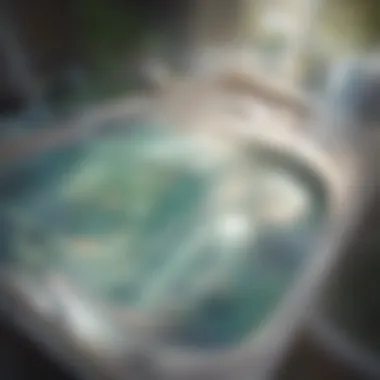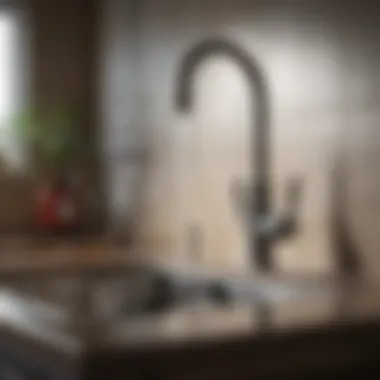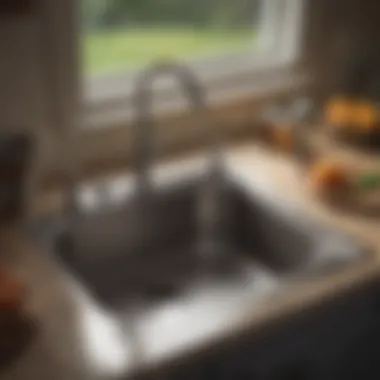Effective Strategies for Unclogging Your Kitchen Sink


Intro
Clogged kitchen sinks are a common issue that many encounter, yet the methods to fix them often remain underappreciated. This situation usually leads to frustration and, in some cases, a call for professional help. However, understanding the various strategies for unclogging a kitchen sink can not only save time and money but also empower homeowners to tackle plumbing problems effectively.
In this article, we will cover practical solutions ranging from simple household items to more advanced techniques. We will discuss why clogs occur, how to identify the type of clog, and the effective tools necessary for resolution. It is essential to approach this matter with a systematic mindset, ensuring that preventative measures are taken to avoid future occurrences.
By exploring these varied techniques, we aim to equip you with a comprehensive toolkit for addressing common kitchen sink clogs. Let’s delve into the strategies that will enhance your maintenance skills and potentially minimize the need for costly repairs.
Understanding Kitchen Sink Clogs
Understanding kitchen sink clogs is essential for any homeowner or renter who values the efficiency and cleanliness of their kitchen. Clogs can lead to slow drainage or complete blockage, which creates inconvenience and generates unpleasant odors. Gaining insight into the common causes and types of clogs helps in implementing effective strategies for prevention and repair. Knowing what contributes to clogs means having the ability to take better care of plumbing, thereby saving time and potential repair costs in the long run.
Common Causes of Clogs
Food Residue
Food residue is one of the primary offenders when it comes to kitchen sink clogs. Small bits of food that escape during washing can accumulate over time, leading to significant blockages. This aspect of food residue is important because it is often overlooked. Its sticky nature allows it to adhere to the insides of pipes, making it a common contributor to clogs. The advantage of understanding this characteristic is that homeowners can take proactive steps like using a food catcher or being more mindful about what gets washed down the sink. However, neglecting this can lead to more serious plumbing issues.
Grease Buildup
Grease buildup is another critical factor in clog formation. Cooking oils and fats often find their way into the sink, solidifying as they cool. This buildup can create clogs that are hard to remove because they are dense and sticky. The main characteristic of grease is that it combines with food debris, creating a strong bond that can obstruct water flow. The disadvantage here is that many people underestimate how much grease can accumulate over time, leading to costly plumbing repairs if not addressed properly.
Foreign Objects
Foreign objects can unexpectedly become a source of kitchen sink problems. Items like utensils, small toys, or packaging materials sometimes make their way into the drain, causing blockages that are often complete rather than partial. The key feature of foreign objects is their unpredictable nature; unlike organic matter, they can cause immediate clogs that obstruct drainage completely. An important note for homeowners is to educate everyone in the household about proper disposal methods to minimize this risk.
Types of Clogs
Partial Clogs
Partial clogs refer to a situation where some water can still drain but at a significantly reduced rate. They often result from a combination of food residue and grease, making detection less urgent but still necessary. Recognizing partial clogs early is crucial because they can lead to more severe blockages. The downside of ignoring them is that they can escalate quickly if not treated promptly.
Complete Clogs
Complete clogs represent the most severe form of blockage. In this case, water does not drain at all, causing frustrating overflow in the sink. The key characteristic of complete clogs is their sudden onset, often stemming from either grease buildup or foreign objects. Homeowners should act quickly to resolve these issues; otherwise, they risk damaging plumbing systems or requiring extensive repairs.
Recurring Clogs
Recurring clogs are an indicator of an underlying issue, possibly related to pipe structure or chronic buildup problems. The unique characteristic of recurring clogs is their persistent nature; they reappear even after attempted remedies, often signaling a need for professional plumbing help. Addressing these issues early is key to avoiding the hassle of constant maintenance and the potential for plumbing failure.
Proper understanding of the types and causes of clogs allows for better management and intervention strategies.
Assessment and Diagnosis


Assessment and diagnosis are crucial steps in dealing with kitchen sink clogs. Proper identification of the issue allows for the most effective intervention to take place. Understanding the symptoms and using the right tools can save time and effort. By diagnosing the type of clog, homeowners can avoid guessing and potentially exacerbating the problem.
Identifying Symptoms of a Clog
Understanding the symptoms of a clog is essential for effective management. Recognizing these signs early can prevent more severe and costly issues down the road. Here are three common symptoms to look for:
Slow Draining
Slow draining is often the first indication of a potential clog. Water may take longer than usual to pass through the sink. This can indicate a buildup of grease or other materials in the pipes. A key characteristic of slow draining is the gradual nature of the problem. It often starts mildly before becoming more pronounced. This gradual onset makes it easier for homeowners to overlook the issue. However, addressing this symptom as soon as it’s noticed can help to avoid further complications. The unique feature of slow draining is that it can be intermittent, appearing only during certain times of use. While this may seem manageable, it is wise to act on it promptly.
Backed Up Water
Backed up water is a more alarming symptom, as it usually indicates that the clog is significant. Water that does not drain at all can accumulate in the sink, making it unusable. This is a critical sign that attention is needed. The key characteristic here is that it prevents normal usage of the sink. It highlights a blockage that needs immediate resolution. The unique feature of this symptom is its immediate impact on daily routines, as it effectively halts kitchen activities. This symptom provides a clear cue for homeowners to take action. However, sourcing the cause can sometimes lead to a deeper issue in the plumbing system.
Gurgling Sounds
Gurgling sounds coming from the sink can be another indicator of a clog. This sound often occurs as air is forced through the pipes due to a blockage. The key characteristic is that it typically precedes a complete clog, signaling that immediate attention is necessary. The uniqueness of gurgling sounds lies in their auditory nature, catching the attention of those in the vicinity even when visual symptoms are absent. While it might appear minor compared to backed-up water, it can serve as a useful warning. Ignoring it may result in a more severe blockage and subsequent inconvenience.
Using Tools for Diagnosis
Effective diagnosis often requires the use of specific tools. These tools can help ascertain the severity and type of clog present. Here are three tools commonly used:
Plunger
The plunger is a fundamental tool for diagnosing blockages. Its primary function is to create pressure and remove smaller clogs. The key characteristic of a plunger is its accessibility and ease of use. It is readily available in most homes and can be a first line of defense against clogs. The unique feature of the plunger lies in its manual operation, allowing control over the force applied. However, it may not always be effective for more serious clogs, and repeated attempts can lead to frustration or damage to the plumbing.
Drain Snake
A drain snake is a tool designed for deeper clogs, reaching further down into the plumbing. It provides a mechanical means of breaking up tough blockages. Its key characteristic is versatility, as it is suitable for various types of clogs. The unique feature of the drain snake is its length and ability to navigate bends in the pipes. While effective, the main disadvantage is the skill required to use it properly. Improper handling may cause pipe damage.
Camera Inspection
Camera inspection is a modern solution for diagnosing plumbing issues. This method employs a small camera to observe and identify clogs within the pipes. The key characteristic of camera inspection is its precision. It allows for a clear view of the issue without invasive measures. Its unique feature is the ability to uncover hidden problems that traditional tools might miss. However, the downside is cost, as this service often requires professional involvement. Understanding these tools and symptoms can empower homeowners to tackle clogs more effectively.
Basic Unclogging Techniques
The execution of basic unclogging techniques is essential for maintaining a functional kitchen sink. Many homeowners encounter clogs, often at the most inconvenient moments. Knowing how to remedy these situations with simple methods can save time and frustration. Moreover, these techniques require minimal investment in tools or materials, making them accessible to almost anyone. Utilizing these strategies also fosters greater understanding of plumbing systems, enabling better long-term care for your fixtures.
Boiling Water Method
The boiling water method is a straightforward yet effective technique for addressing mild clogs. This approach capitalizes on the principle that heat can dissolve or loosen blockages caused by grease or soap buildup. To perform this method, bring a pot of water to a rolling boil. Carefully pour this boiling water directly down the drain in two or three stages, allowing a few seconds in between to maximize its effectiveness.
Important Note: While this method works well for soft clogs, it is not suitable for all types of pipes. Avoid using boiling water on PVC pipes, as it may cause damage.


Vinegar and Baking Soda
Using vinegar and baking soda is a popular home remedy for clogs, relying on a chemical reaction to clear blockages. The process begins with pouring a cup of baking soda down the drain, followed by a cup of vinegar. This mixture creates a foaming action that can dislodge debris and grime. After allowing it to sit for about 15-30 minutes, flush the drain with hot water to clear any remaining residue. This technique is eco-friendly and minimizes the use of harsh chemicals, making it a considerate option for those concerned about environmental impact.
Plunger Utilization
The plunger is a classic tool in unclogging strategies, especially designed for small to moderate blockages. To use a plunger effectively, ensure there is enough water in the sink to cover the suction cup. Place the plunger over the drain and create a firm seal. Pump the handle vigorously while maintaining the seal, then quickly pull the plunger up to create suction. This action can dislodge the clog and restore drainage. It may require several attempts, but the plunger is a reliable option when other methods fail.
By implementing these basic techniques, homeowners can often resolve initial clogging issues efficiently, thus reducing the need for professional intervention.
Advanced Techniques for Stubborn Clogs
When basic unclogging methods prove ineffective, exploring advanced techniques becomes necessary. Stubborn clogs can arise from various factors, including deep-seated grease buildup and foreign debris that simple home remedies cannot dislodge. Understanding these advanced techniques enhances one's ability to manage persistent clogs, ensuring a functional kitchen sink and avoiding more severe plumbing issues.
Using a Drain Snake or Auger
A drain snake, also known as an auger, is a valuable tool in tackling stubborn clogs. It consists of a long, flexible metal coil that can reach deep into the plumbing system. This device allows the user to break up and collect debris that regular plungers or boiling water cannot handle.
When using a drain snake, you insert the tip into the drain until you feel resistance. Then, you can crank the handle to extend the coil further into the pipe. Depending on the clog's nature, you may need to push or twist the snake to break up the blockage. It's crucial to proceed with care to avoid damaging the pipes.
Consider wearing gloves and ensuring your workspace is protected from any potential mess.
Hydro Jetting
Hydro jetting offers a robust solution for severe clogs. This method employs high-pressure water jets to clear out debris, grease, and other obstructions that have accumulated over time. Skilled professionals typically conduct hydro jetting, as it requires specialized equipment and knowledge to ensure it is done safely and effectively.
The benefits of hydro jetting include:
- Thorough cleaning: It clears not just the immediate clog but also the entire pipe.
- Long-lasting results: Maintaining clean pipes can prevent future blockages.
- Environmentally friendly: This method utilizes only water, minimizing chemical usage.
However, hydro jetting may not be suitable for all plumbing systems. Older pipes may be damaged by the intense pressure, making it essential to consult a professional before proceeding.
Professional Plumbing Services
At times, enlisting the help of professional plumbing services is the most pragmatic approach to managing stubborn clogs. Professionals possess the expertise, tools, and experience necessary to diagnose and resolve issues that a homeowner may not fully understand. This option also alleviates the risk of further damage resulting from improper techniques or tools.
Before hiring a plumber, consider the following:
- Check qualifications: Ensure they are licensed and insured.
- Read reviews: Look for feedback on their reliability and effectiveness.
- Get estimates: Understand what you might be charged for their services.
Preventative Measures
Preventative measures are essential in maintaining the functionality of your kitchen sink. Addressing potential issues before they escalate saves time, effort, and money. By adopting certain strategies, you can significantly reduce the likelihood of clogs and associated complications. Knowing how to prevent clogs not only protects your plumbing but also contributes to the overall hygiene and efficiency of your kitchen.
Regular Cleaning and Maintenance


Routine Inspection
Routine inspection involves regularly checking your sink and plumbing system for any signs of wear or buildup. The key characteristic of routine inspection is its proactive nature. It allows for the identification of potential issues before they become significant problems. This practice is beneficial for homeowners looking to maintain their kitchen plumbing effectively. A unique feature of routine inspection is its simplicity; it requires minimal tools and effort.
The advantages of routine inspections include the early detection of minor clogs or leaks, which can save on costly repairs. Regular checks encourage a habit of cleanliness, allowing you to keep your pipes in good condition. However, the disadvantage might be that it requires a commitment of time and attention, which some may find challenging to maintain consistently.
Using Drain Covers
Using drain covers is another effective way to prevent clogs in your kitchen sink. The primary focus here is on physical blockage of foreign objects and food particles from entering the drain. This method is a popular choice as it effectively reduces the accumulation of debris in your plumbing system. A significant feature of drain covers is their mesh design, allowing water to pass through while filtering out larger particles that could cause clogs.
The advantages of using drain covers include ease of installation and maintenance. They can be easily removed for cleaning, facilitating a cleaner kitchen environment. On the downside, there is a risk of blockage if the cover itself is not cleaned regularly. Accumulated debris on the cover could lead to water backup if not managed properly.
Proper Disposal Techniques
Compost Sorting
Compost sorting is a technique that promotes eco-friendly waste management by ensuring that organic material is disposed of correctly. Its contribution is significant as it limits the amount of food waste that could otherwise clog the sink. The key characteristic of compost sorting is its ability to divert decomposable waste away from the plumbing system. This method is beneficial as it contributes to environmental sustainability.
A unique feature of compost sorting is its dual purpose; not only does it prevent clogs, but it also supports gardening and plant health through nutrient-rich compost. However, the downside is that it requires a commitment to separation of waste, which some may find labor-intensive.
Avoiding Grease Disposal
Avoiding grease disposal is crucial for maintaining clear drains and avoiding kitchen sink clogs. The emphasis here is on the prevention of grease buildup, which can harden in pipes and lead to serious blockages. This practice is a popular and effective choice among homeowners. The distinctive feature of avoiding grease disposal is the necessity of changing disposal habits, as many find it convenient to wash grease down the drain.
The advantages of this technique include maintaining a smoother plumbing system and reducing the frequency of plumbing problems. The main disadvantage, however, is the practicality of disposing of grease properly. Many individuals may find it more difficult to adjust their habits, which can lead to continued issues if not addressed properly.
Understanding When to Seek Help
Determining when to seek professional assistance for a clogged kitchen sink is an important aspect of home maintenance. While many homeowners feel confident tackling small clogs with DIY methods, some situations call for expert intervention. Recognizing these instances can save time and prevent further damage to plumbing systems. Knowing when to call a professional not only alleviates stress but also ensures that the problem is dealt with properly from the get-go.
Identifying Severe Problems
Frequent Recurring Issues
Frequent recurring issues with kitchen sink clogs often indicate a deeper plumbing problem rather than just simple blockages. Homeowners may find themselves repeatedly unclogging their sinks, which can lead to frustration and wasted time. This characteristic is particularly concerning because it suggests that the underlying cause has not been addressed. The unique feature of this issue lies in the potential for serious damage to pipes. Ignoring frequent recurring clogs can lead to costly repairs, making it essential to investigate rather than simply react.
Underlying Plumbing Problems
Underlying plumbing problems include issues such as damaged pipes, tree roots infiltrating drainage systems, or even issues with the municipal sewer lines. These situations contribute significantly to recurring kitchen sink problems as they often require a specialized approach to remediate. The key characteristic of these issues is their complexity; identifying them typically goes beyond standard consumer remedies. The unique feature of underlying plumbing problems is that they require technical skills and tools to resolve, thus justifying the need for professional help. Ignoring such issues can lead to leaks or even a full plumbing failure, emphasizing the importance of recognizing when it's time to seek assistance.
Key Signs to Contact a Professional
Identifying critical indicators can clarify whether an issue is manageable through DIY methods or necessitates a professional touch.
Multiple Sink Clogs
Multiple sink clogs across various locations in the home can suggest systemic problems within the plumbing system. If sinks in different bathrooms or the kitchen drain simultaneously, it’s a strong indicator of major issues, such as clogs in the main sewer line. The key characteristic of multiple sink clogs is their broad impact, which often signifies that the problem is not localized. The unique feature of this situation is that it requires a thorough examination of the entire plumbing network, hence the recommendation to consult a professional who can correctly diagnose the situation and offer effective solutions.
Unusual Drainage Behavior
Unusual drainage behavior, such as gurgling noises or water draining slowly, can serve as red flags. These symptoms often indicate that there are blockages forming, which could escalate if ignored. The essential aspect of unusual drainage behavior is its indication of ongoing issues that may worsen. A notable characteristic of this behavior is that it may not solely pertain to the kitchen sink, extending to issues in other plumbing fixtures. Addressing unusual drainage behavior early with the help of a professional can prevent more severe plumbing problems down the line.







